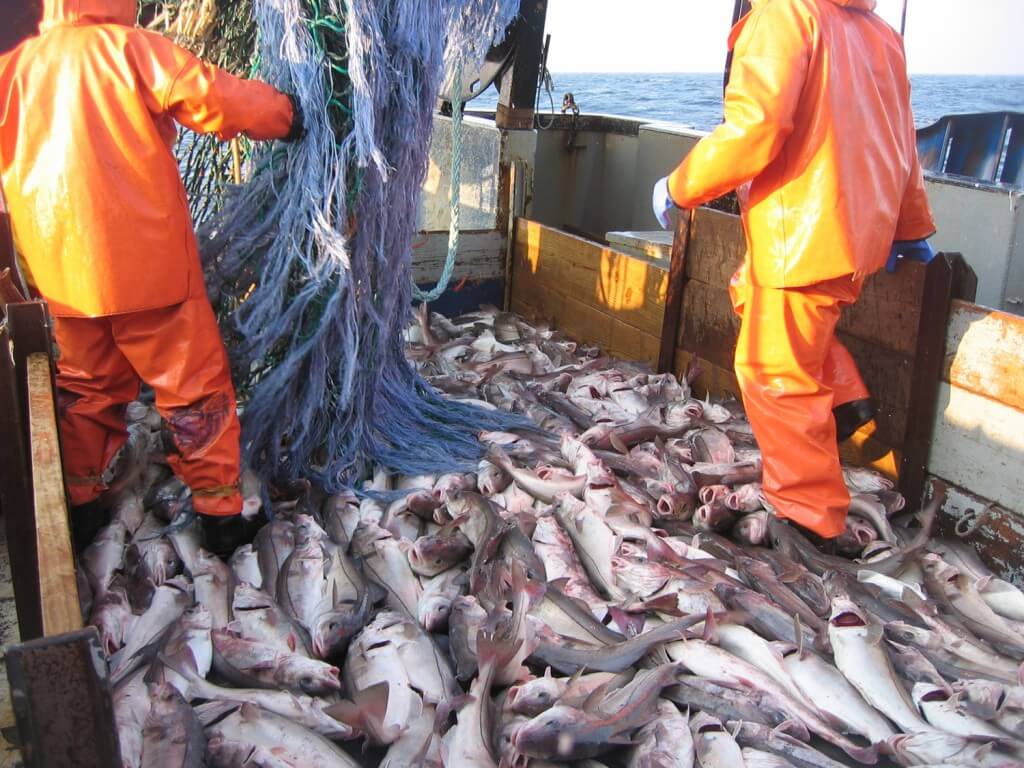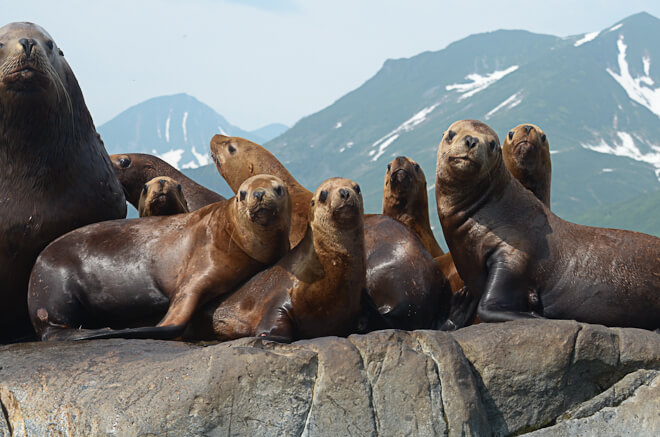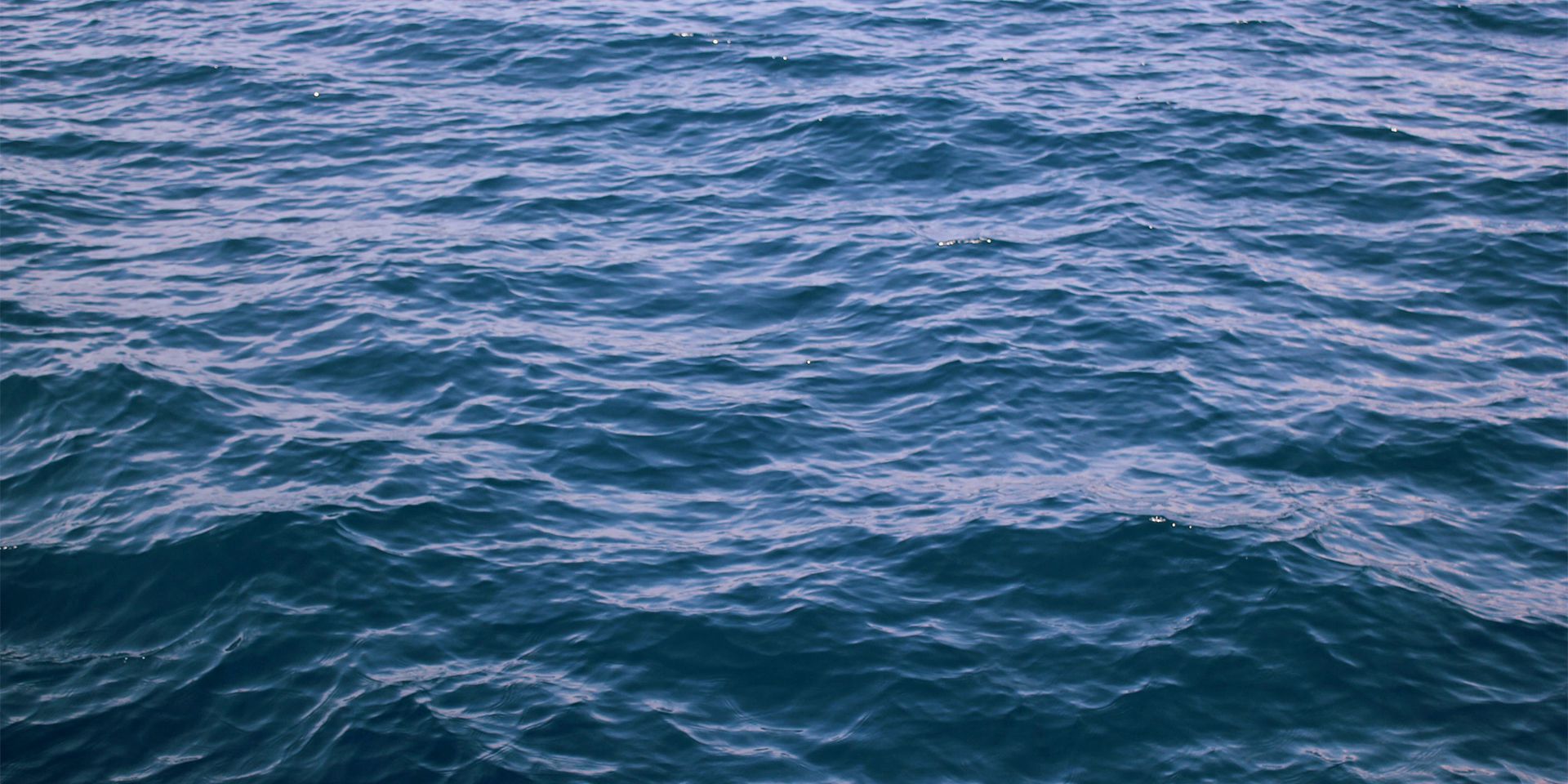Fisheries Interactions with Marine Mammals
Commercial fishing operations are the largest cause of human-related injury and death for many marine mammals. The Marine Mammal Commission supports and strives to advance sustainable fisheries practices that minimize the impact to marine mammals and their environment. The Marine Mammal Protection Act (MMPA) establishes an extensive research and management framework for assessing and mitigating marine mammal bycatch in commercial fisheries. A key feature of this framework has been the development of take reduction plans developed in consultation with take reduction teams to reduce high levels of marine mammal bycatch. While this process, in most but not all cases, has resulted in considerable progress in reducing marine mammal bycatch, additional scientific and management efforts are needed to address the indirect impacts of fishing on the complex predator-prey dynamics for marine mammals.
2019 Annual Meeting
In Hawaii, as in many places around the world, many odontocetes (dolphins and toothed whales) take bait or catch off fishermen’s hooks (depredation), and are occasionally, accidentally caught themselves. In part, the Commission’s 2019 Annual Meeting focused on this problem, considering the factors affecting this form of bycatch in Hawaii and methods for its mitigation.
Fisheries can have negative or positive impacts on marine mammals, and the reverse is also true. Direct negative impacts on marine mammals include unintentionally injuring or killing them, or intentionally harvesting them. Indirect negative impacts include reducing the availability of, or altering the size or diversity, of their prey. Habitat degradation caused by certain fishing activities (e.g., bottom trawling) can also have an indirect, negative impact on marine mammals that depend on those habitats for food. Conversely, fisheries can have a positive impact on marine mammals by increasing the availability of prey, which can happen directly when fishing gear flushes or concentrates fish, which then are consumed by marine mammals before they are caught by the gear, or indirectly by increasing the abundance of preferred prey, perhaps by reducing the abundance of the prey’s competitors or predators. Marine mammals can have a direct, negative impact on fisheries by removing bait or caught fish from hooks, nets, or traps or mariculture pens (a behavior called depredation), scaring fish away from fishing gear, or damaging or removing fishing or mariculture gear. In some cases, fishermen seeking to protect their gear or, catch or penned fish may harass marine mammals that are interacting with their gear, sometimes, perhaps inadvertently, causing injury or death.
Direct Fisheries Interactions
Bycatch

Fishermen sort their catch from an “eliminator trawl” (Rhode Island Sea Grant)
Bycatch is the number one source of direct human-caused death and serious injury to marine mammals worldwide, estimated at over 650,000 individuals each year. Two important publications (see the Learn More section of this page) have highlighted the significant threat that gillnets, in particular, pose to marine mammals around the world. While the United States has made significant progress in reducing the impact of fisheries operations on marine mammals, fishery bycatch remains a serious problem in other countries. In some cases, fishery bycatch threatens to drive species, such as the vaquita in the Gulf of California, to extinction. Although marine mammals can be bycaught in gear being actively fished, they can also be bycaught in lost, abandoned or discarded gear, a phenomenon called ‘ghost fishing.’ One review of 76 publications on this topic found reports of over 1800 cetaceans entangled in ‘ghost gear’. While the United States is a leader when it comes to sustainable fisheries management, over 90 percent of the seafood we consume is imported. For this reason, the Commission supports regulations by the National Marine Fisheries Service that fully implement Section 101(a)(2) of the MMPA requiring import bans on seafood caught in foreign fisheries whose bycatch injures or kills marine mammals in excess of U.S. standards.
Depredation
In some fisheries, marine mammals are known to remove catch or bait (depredation) regularly from fishermen’s lines or nets, and some species (primarily pinnipeds) take fish from mariculture pens. Over thirty species of odontocetes are known to engage in depredation. For example, some individuals in populations of sperm, killer, false killer, and pilot whales around the world have become adept at removing a variety of fish species from longline hooks, a behavior also exhibited by other toothed whales and dolphins in a wide range of fisheries. Other species have learned to take catch from trawl or gill nets. Unfortunately, depredating marine mammals occasionally make a mistake and are hooked or trapped, which can result in serious injury or death.

Steller sea lions range along the North Pacific Rim from northern Japan to California. (NOAA’s National Marine Mammal Laboratory)
Depredation can significantly affect the volume and quality of catches, and therefore profits, lead to fishermen taking potentially deadly retaliatory actions, and increase the likelihood of entanglement or hooking of marine mammals. The Commission is working with the National Marine Fisheries Service (NMFS) and other partner agencies to better understand impacts of depredation on marine mammals and find possible solutions, such as through the development of non-lethal deterrents aimed at minimizing interactions between marine mammals and fishing gear. In early 2018, NMFS increased the threat categorization of a sablefish longline fishery in the Gulf of Alaska because of the potential for depredating sperm whales to be caught and seriously injured or killed (see Commission letter commenting on this action).
In December 2014, NMFS sought comment on their intent to prepare national guidelines for the use of marine mammal deterrents (e.g., acoustic scaring devices, electrical wires, water jets, rubber bullets) that would not cause serious injuries or death. In response, in its recommendations the Commission emphasized the importance of clearly distinguishing between serious and non-serious injuries, using deterrents only when warranted, and preventing unrestricted use of noisemakers. To assist NMFS in its efforts, a Commissioner and Commission staff member attended a NMFS-hosted workshop in 2015 addressing non-lethal marine mammal deterrents for fishery operators as well as others impacted by recovering species. NMFS published a proposed deterrents guidelines in August 2020, but as of April 2021, the agency has yet to issue the final deterrent guidelines, nearly over six years after seeking public comment. In 2017, the Commission provided funding via its grant program to the Woods Hole Oceanographic Institution to characterize depredation in Northeast U.S. sink gillnet fisheries.
Several reviews of depredation occurring in a wide variety fisheries around the world have found that deterrents such as explosives and acoustic deterrent devices (ADDs) are largely ineffective. Changes in fishing gear (e.g., hook protectors or stronger traps) and practices (e.g., avoiding some areas or moving when depredation occurs) have proven to be much more effective.
The Commission works with the False Killer Whale Take Reduction Team and NMFS to amend the regulations of the Hawaii deep-set longline fishery to further reduce the likelihood that false killer whales are killed or seriously injured while depredating catch and bait in that fishery. Similarly, the Commission is working with the Pelagic Longline Take Reduction Team to reduce the bycatch of depredating pilot whales and Risso’s dolphins in by the Atlantic pelagic longline fishery to insignificant levels.
Indirect Fisheries Interactions
Indirect impacts of fisheries operations on marine mammals include competition for prey and damage or destruction of sensitive marine mammal habitat. While these and other indirect effects could be significant, they have received less attention by scientists and fishery managers, in part because of the difficulties in understanding complex marine ecosystems and food webs. Globally, fisheries have significantly reduced the size of many fish stocks and continue to unsustainably exploit them year after year. Removing a large portion of the biomass of a target fish stock may have severe effects on marine mammals and other predators that prey on the stock. In addition, some types of trawl and dredge fishing have been shown repeatedly to significantly alter the physical and biological structure of sensitive marine habitats, potentially affecting marine mammals that depend on those habitats.
Competition between fisheries and marine mammals is an issue in many fisheries. For example, in southeast Alaska, fishermen catching urchins, clams, and crabs have voiced concerns that sea otters are reducing their catches by consuming these species as part of their diet. Also, the impact of fisheries taking the prey of endangered Steller sea lions in Alaska or Southern Resident Killer whales in Washington has long been a concern and controversy. Reduction in key prey species by fishing could compromise the sea lions’ foraging efficiency and, consequently, their ability to survive, grow to maturity, and reproduce at rates sufficient for the population to recover. In part to mitigate this risk, fisheries management in the Aleutian Islands includes measures designed to reduce the fisheries depletion of certain fish stocks in areas of particular importance to Steller sea lions.
The Commission believes that indirect effects of fishing on marine mammal prey resources should be considered when establishing catch limits for fish stocks developed under fishery management plans required by the Magnuson-Stevens Fishery Conservation and Management Act. We have provided recommendations on proposed revisions to NMFS’s Magnuson-Stevens National Standard 1 Guidelines, highlighting some of our concerns regarding the impact of fisheries harvest on marine mammals. In particular, we recommend that the guidelines for determination of “Optimal Yield” adequately incorporate ecological factors, such as the role of the target fish species in the ecosystem, such as forage fish.
Marine mammals can consume substantial amounts of fish, in some cases comparable amounts to that taken by fisheries. It can be tempting to infer that marine mammals must be reducing the availability of fish to fishermen, but demonstrating such a link has proven to be very difficult because of the complexity of marine ecosystems, and because marine mammals are often only taking related species or size classes that are not targeted by fishermen. Similarly, clear demonstrations are lacking that fisheries have reduced marine mammal prey availability to limiting levels. A recent ecosystem simulation study of fisheries and three cetacean species in the Rías Baixas shelf ecosystem (North-West Spain) concluded that intense fishing would reduce the variety of available prey and lead to competition among the cetaceans.
The Atlantic States Marine Fisheries Commission’s (ASMFC) Menhaden Management Board has developed ecological reference points that take into account the requirements of menhaden predators, such as marine mammals, and that will be used to set ecosystem-based catch targets and limits. In a 24 October 2017 letter, the Commission encouraged the ASMFC to implement the use of ‘rule-of-thumb’ ecological reference points (ERPs) to manage the menhaden fishery until ERPs specific to this fishery can be developed. Stock assessment scientists with the ASFMC and NMFS completed development of the ERPs, and in January 2020 published a stock assessment of Atlantic menhaden using ecological reference points. In August 2020, the ASFMC approved ERPs that take into account the impact of menhaden fishing on striped bass. Although, the impact on marine mammals was found to be minimal, the development of ERPs that account for the needs of predators is an important step forward in fisheries management.
LEARN MORE
General Information
Marine Mammal Bycatch (Marine Mammal Commission)
Fisheries Interaction (NOAA Fisheries)
